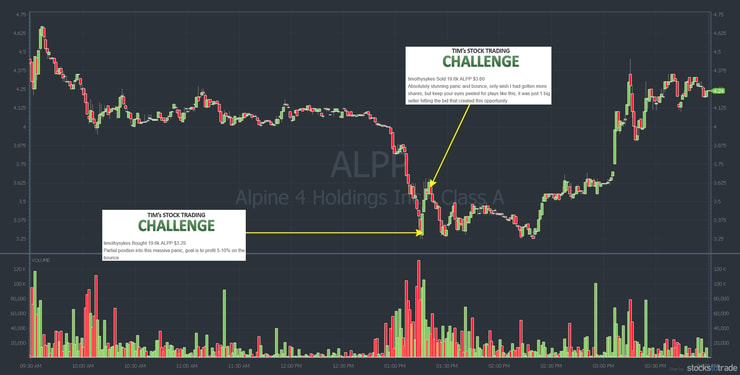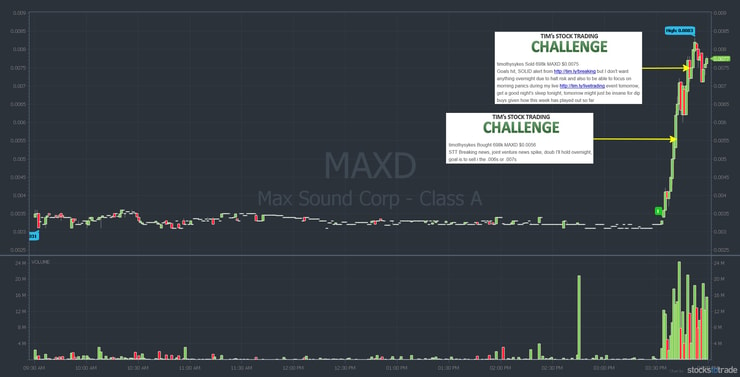Aye, aye, aye. It doesn’t have to be complex, but you MUST use risk management if you want to stay in the penny stock game. Too many newbies got crushed last week as the OTC market plummeted.
It’s a combination of believing promoter BS, and thinking ‘stonks go up’ is the new paradigm. It’s not. Keep reading for three simple penny stock risk management tips.
First…
Table of Contents
Karmagawa Proud
Underwater cinematographer André Musgrove worked with us on the Save the Reef documentary. Watch “50 Minutes to Save the World” if you haven’t already. There’s a reason it has over 12 million views.
Now I’m happy to share André’s new release…
Sharks of South Africa with Karmagawa
Be sure to pay particular attention at the 6:22 mark. We MUST put an end to this horrible treatment of sharks. As an apex predator, sharks are essential for maintaining the delicate underwater ecosystem.
+$7.3k today for me, overtrading a bit on $WSGF $VPER $OZSC $TSNPD but glad to be green on the day & to donate it ALL to charity! See my new charity video on why we must #savethesharks that just debuted https://t.co/bswNRDYiMb & I hope you stayed safe in this ugly $DIA $SPY $QQQ
— Timothy Sykes (@timothysykes) March 3, 2021
Keep up the great work, André!
Learn more about South African Shark Conservancy here.
Speaking of Karmagawa…
Check out our brand-new, limited-edition, sustainable merch…
I'm VERY proud to announce our brand new limited edition @karmagawa charity merch, check it out https://t.co/SRxSLkO9dR it's #sustainablefashion & 100% of the profits get donated to charity…we're announcing a $700,000+ donation later this week, I'm SO proud of our entire team! pic.twitter.com/yDMbQ58SbW
— Timothy Sykes (@timothysykes) March 3, 2021
Help support Karmagawa’s mission when you buy merch here.
Coming soon to the blog, details about our recent $700,000 in donations…
⚠️GOOD NEWS FRIDAY!⚠️ I was SO proud to help sponsor a dog rescue of 15 dogs to save them from the slaughterhouse as this rescue was part of our newest $750,000 in @karmagawa donations to various charities to help animals and communities in need, details coming next week! pic.twitter.com/HkHthOV4Ot
— Timothy Sykes (@timothysykes) March 5, 2021
Dream Big, Work Hard, Give Back
Success as a penny stock trader isn’t easy. It requires studying and a lot of practice trading small. Only then, over time, does it make sense to size up. Remember, most traders lose.
The big obstacle most newbies face isn’t a lack of desire. You wouldn’t believe the number of emails and DMs I get from people who say they want to learn. They even say they’re willing to put in the effort. But most traders give up WAY too soon.
The obstacle is a lack of dedication and determination over time.
How do you overcome it? Dream big. I can’t tell you what to dream about — but I can tell you what drives me. My passion is giving back. It’s my big ‘why’ for teaching and trading.
11:11pm dream check, retweet/favorite this if you promise to dream big & work hard to make your dreams come true as whatever you want in this life CAN happen…now I'm writing a press release about my charity's new $700,000 in donations, pushing us over $6+ million donated total! pic.twitter.com/Poxl3QhJAC
— Timothy Sykes (@timothysykes) March 4, 2021
So dream big, and then get to work. Use your dreams as motivation. When you question why it’s so important to study today, think about your why. When you wonder why you need to have a clear risk management system, focus on your dream.
Trading Mentor: Penny Stock Risk Management 101
I don’t know how many times I have to say it. But I’m going to say it again…
Rule #1 is to cut losses quickly. I know there’s a lot of BS out there. And the past couple of months when everyone was on the ‘stonks go up’ bandwagon, newbies got sucked in. The promoters fed them ‘due diligence’ and hot picks.
Their greed glands got the best of them. They bought — and no matter how much their next big thing dropped, they held. Sadly, last week they got hit in the face with cold, hard reality.
Stocks don’t just go up.
More Breaking News
- FuboTV Faces Roller Coaster Ride Amid Ongoing Business Turmoil and Legal Scrutiny
- Guardant Health: Unraveling the Surprisingly Flourishing Revenue Trajectory
- Trio Petroleum Corp.: An Unexpected Surge and What It Means for Investors
Day Trading Risk Management Rule #1
You do NOT have to hold through 20%, 30%, or 50% drawdowns. Nor should you. But it goes deeper than just knowing to cut losses quickly. Yes, that’s rule #1. But knowing why it’s so hard for some people to follow rule #1 might help. There are two main reasons: stubbornness and ignorance.
Stubbornness is something all traders need to work on. I don’t care how good you are, there will come a time when stubbornness will cause a big loss. Be wary. The market doesn’t care what you think or what you want to happen.
But the second reason newbies don’t cut losses quickly — ignorance — is scarier. They actually believe in the company. They accept hype as reality. They believe promoters and their BS due diligence.
Read last week’s update about OTC fairy tales. Most of these companies have zero revenue, no product, and no hope of ever turning a profit. I don’t care how amazing the due diligence is — it’s not going to the moon. Ever.
Please understand, I don’t hate these companies. I’d love to see one become successful, like True Religion Jeans did back in the day.
True Religion traded on the Nasdaq as TRLG. In 2013, private investment firm TowerBrook purchased it for $32 per share. Long-term shareholders got a good deal. Mind you, True Religion just emerged from its second bankruptcy in three years. So much for the little penny stock that could…
I expect the worst so I’m never disappointed. It’s not random — it’s from experience. My biggest ever loss made me cynical and opened my eyes to how fake and fraudulent this industry is.
3 Penny Stock Risk Management Tips

These are overarching risk management tips. Start with these, then apply them to any risk management system you use…
Penny Stock Risk Management Tip #1: Expect the Worst From Every Company
Yes, I learned the hard way. It’s all described in detail in my no-cost book “An American Hedge Fund.” Read it and you’ll understand why I’m cynical.
Penny Stock Risk Management Tip #2: Know That What You Buy Is Junk
Twitter pumpers love to hype up stocks with BS due diligence. The number of times I read “Know what you buy” or “Know what you own” every day is crazy.
What you own is junk.
It’s promoted. I’m not saying don’t trade it. Just admit that it’s not world-changing tech. It’s not the next PayPal, Amazon, or Microsoft. And it’s not going to make you rich. No one trade will make you wealthy.
Penny Stock Risk Management Tip #3: Take Responsibility for Your Trades
Not only should you take responsibility for your trades, but you should also do it from start to finish. Never follow alerts to get into a trade.
I do my best to educate people. I work hard to expose the BS in this industry. But, ultimately, it’s up to you to learn.
Far too often, newbies and undisciplined traders go down with the ship. Then they blame manipulation, short sellers, or even promoters for their losses. But the only person they should blame is themselves.
Losing 40%, 50%, or even 90% on a stock dropping every day is inexcusable. And it’s YOUR fault if you do it. Getting caught once or twice in a panic can happen to anyone. But to hold and hope on a dying pump is the epitome of stupid.
All I can do is get the information out there.
You can believe me, or believe the BS promoters saying, “Only the weak sell…”
Here’s my question to you…
What’s your outcome? Do you REALLY think you’re going to retire on one of these pumps? You’re NOT. They’re JUNK.
This is why 90%+ of traders lose, listening to others, not having rules/discipline & not realizing that "solid DD" doesn't amount to shit outside of a bubble. We're LONG overdue for a serious correction & that's when hold & hope newbies get wiped out so you choose your risk level
— Timothy Sykes (@timothysykes) March 3, 2021
Trade Review: Are Penny Stocks Worth the Risk?
It’s a common question. And there’s no denying it, trading is risky. Penny stock companies are the worst of the worst. So are penny stocks worth it?
That depends on a lot of things, but I will say this … I would NEVER invest in a penny stock long-term. They’re NOT investments — they’re trading vehicles. Remember that.
With that in mind, let’s look at two trades from last week. One was my biggest dollar winner, the other was my biggest percent winner.* Keep in mind that I’ve been trading for 20+ years, lose roughly 25% of the time, and trade conservatively.*
(*Please note: My results are far from typical. Individual results will vary. Most traders lose money. I have the benefit of years of hard work, dedication, and experience. Trading is inherently risky. Do your due diligence and never risk more than you can afford to lose.)
The first is a variation on my favorite penny stock pattern for small accounts…
Alpine 4 Holdings Inc. (OTCQB: ALPP)
ALPP has been on my watchlist since November. That’s when Alpine 4 announced it was entering the drone market.
Take a look at the ALPP one-year chart:
As you can see, ALPP had a big run in December. It formed a near-perfect cup and handle, and then had a solid breakout in February. Then, like 99% of overextended OTCs, it tanked.
Check out the ALPP intraday chart from March 4 with my buy and sell alerts…

My favorite pattern for small accounts is the morning panic dip buy. This panic happened in the afternoon, but it’s a similar play. Once the panic starts, stop losses get taken out along the way. I got out for $6,076 in profit on this 9.42% win.*
(*Note: My results are far from typical. Individual results will vary. Do your due diligence and never risk more than you can afford to lose.)
Now let’s look at my biggest percent winner from last week…
Max Sound Corporation (OTCPK: MAXD)
Max Sound spiked big in February — like many OTCs — and then tanked. Here’s the MAXD one-year chart…
On March 4, Max Sound announced an actual revenue-generating joint venture agreement. Here’s the MAXD chart with my buy and sell alerts…

As you can see, the news catalyst created a huge spike. I only took part of the move for a 33.93% win.* Some students asked why I didn’t hold this one as it was a first green day OTC. Right now, I’m not holding any OTCs overnight. Again, it’s about risk management.
The risk is too high when the SEC suspended trading of several OTCs due to social media manipulation.
Millionaire Mentor Market Wrap
I get questions about specific risk management systems all the time. While cutting losses quickly is rule #1, it’s not the only risk management consideration.
This is where it gets a little counterintuitive, but bear with me…
The Sykes Sliding Scale looks at seven different indicators. One of those is risk/reward. But if you take a step back, the entire Sykes Sliding Scale is like a risk management system.
Not in the sense that I have exact predetermined percentages for losses or gains. And I don’t choose an exact position size based solely on a max allowable loss. It’s not an exact science.
Using the seven indicators gives me a good idea of where I’d like to buy or sell, and why. The important thing to remember is that all seven indicators work together.
For example, time of day matters. So in the ALPP trade above, I probably would’ve taken a bigger position if the panic happened in the morning. And pattern/price action matters. If the panic was bigger, say it took out $3, I might have loaded up.
The MAXD trade is another example using the time of day and the overall market environment.
For more on penny stock risk management, read “The Complete Penny Stock Course.” (See page 133: Risk Management Strategies.)
Most importantly, educate yourself…
FREE Penny Stock Guide
If you’re brand new to penny stocks, read this guide. It will help you understand the potential and risks of trading penny stocks. Access my penny stock guide here.
30-Day Bootcamp
The 30-Day Bootcamp can help you build a solid foundation of my strategies. Plus, you get “The Complete Penny Stock Course” and “Pennystocking Framework” as bonuses. Start the 30-Day Bootcamp today.
Trading Challenge
All my top students come through the Trading Challenge. It’s fully immersive. Come prepared to study like you’ve never studied before. Apply for the Trading Challenge here.
What do you think of penny stock risk management? What do you do to keep yourself safe trading penny stocks? Comment below, I love to hear from all my readers!



Leave a reply